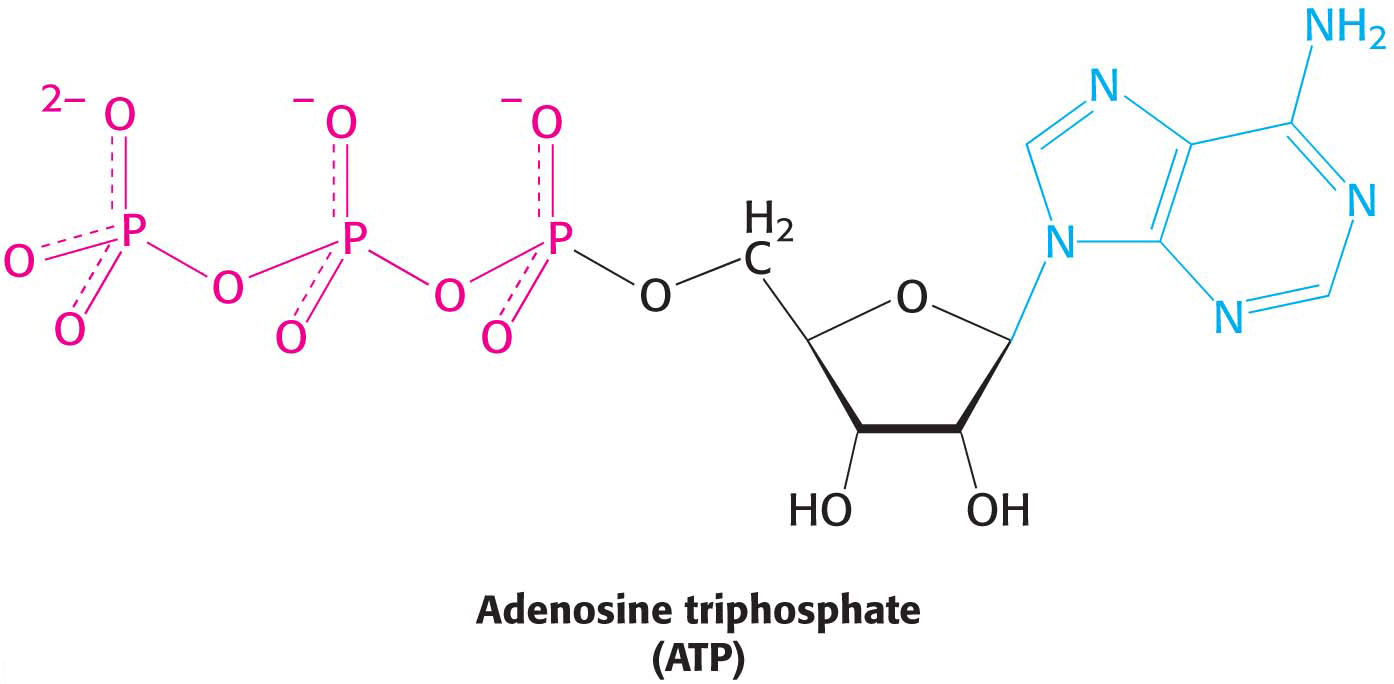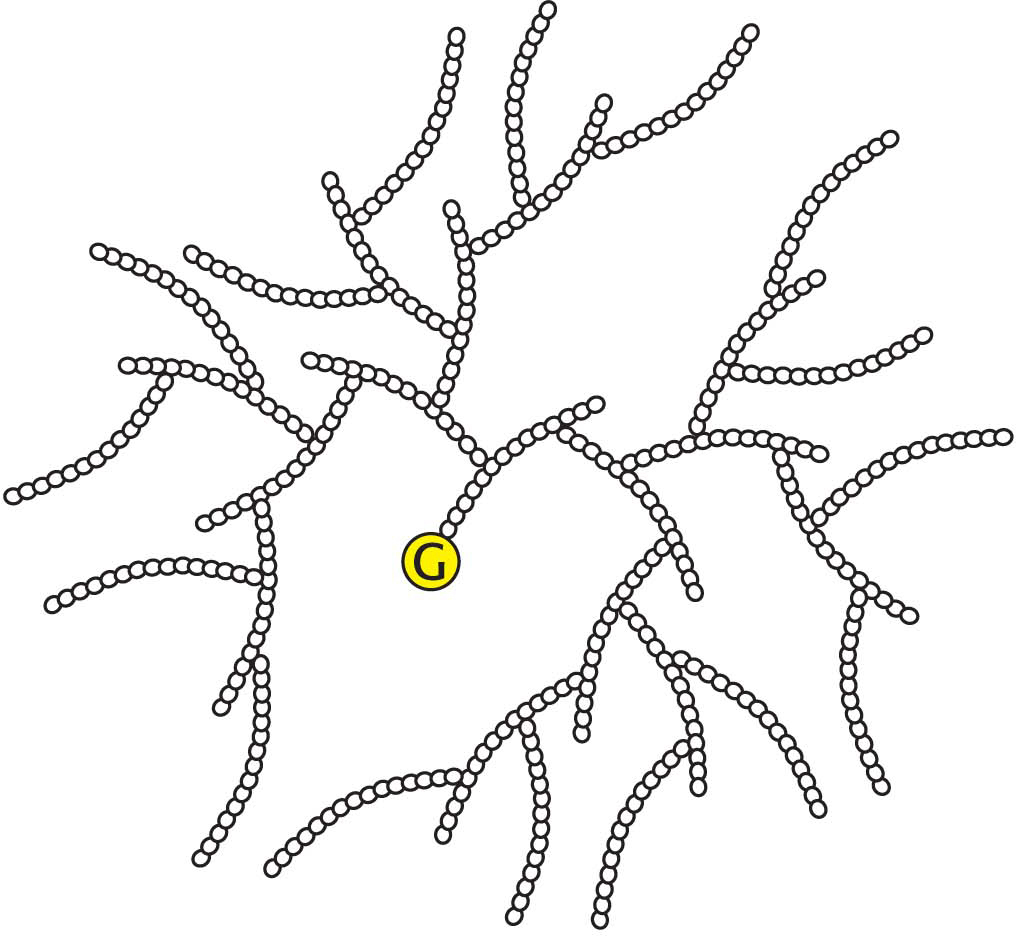Proteins Are Highly Versatile Biomolecules
Much of our study of biochemistry will revolve around proteins. Proteins are constructed from 20 building blocks, called amino acids, linked by peptide bonds to form long unbranched polymers (Figure 1.1). These polymers fold into precise three-dimensional structures that facilitate a vast array of biochemical functions. Proteins serve as signal molecules (e.g., the hormone insulin signals that fuel is in the blood) and as receptors for signal molecules. Receptors convey to the cell that a signal has been received and initiates the cellular response. Thus, for example, insulin binds to its particular receptor, called the insulin receptor, and initiates the biological response to the presence of fuel in the blood. Proteins also play structural roles, allow mobility, and provide defenses against environmental dangers. Perhaps the most prominent role of proteins is that of catalysts—agents that enhance the rate of a chemical reaction without being permanently affected themselves. Protein catalysts are called enzymes. Every process that takes place in living systems depends on enzymes.

Figure 1.1: Protein folding. The three-dimensional structure of a protein is dictated by the sequence of amino acids that constitute the protein.
Nucleic Acids Are the Information Molecules of the Cell

Figure 1.2: The structure of a nucleotide. A nucleotide (in this case, adenosine triphosphate) consists of a base (shown in blue), a five-carbon sugar (black), and at least one phosphoryl group (red).
As information keepers of the cell, the primary function of nucleic acids is to store and transfer information. They contain the instructions for all cellular functions and interactions. Like proteins, nucleic acids are linear molecules. However, nucleic acids are constructed from only four building blocks called nucleotides. A nucleotide is made up of a five-carbon sugar, either a deoxyribose or a ribose, attached to a heterocyclic ring structure called a base and at least one phosphoryl group (Figure 1.2).
There are two types of nucleic acid: deoxyribonucleic acid (DNA) and ribonucleic acid (RNA). Genetic information is stored in DNA—the “parts list” that determines the nature of an organism. DNA is constructed from four deoxyribonucleotides, differing from one another only in the ring structure of the bases—adenine (A), cytosine (C), guanine (G), and thymine (T). The information content of DNA is the sequence of nucleotides linked together by phosphodiester linkages. DNA in all higher organisms exists as a double-stranded helix (Figure 1.3). In the double helix, the bases interact with one another—A with T and C with G.

Figure 1.3: The double helix. Two individual chains of DNA interact to form a double helix. The sugar–phosphate backbone of one of the two chains is shown in red; the other is shown in blue. The bases are shown in green, purple, orange, and yellow.
RNA is a single-stranded form of nucleic acid. Some regions of DNA are copied as a special class of RNA molecules called messenger RNA (mRNA). mRNA is a template for the synthesis of proteins. Unlike DNA, mRNA is frequently broken down after use. RNA is similar to DNA in composition with two exceptions: the base thymine (T) is replaced by the base uracil (U), and the sugar component of the ribonucleotides contains an additional hydroxyl (—OH) group.
Lipids Are a Storage Form of Fuel and Serve as a Barrier
Among the key biomolecules, lipids are much smaller than proteins or nucleic acids. Whereas proteins and nucleic acids can have molecular weights of thousands to millions, a typical lipid has a molecular weight of 1300 g mol−1. Moreover, lipids are not polymers made of repeating units, as are proteins and nucleic acids. A key characteristic of many biochemically important lipids is their dual chemical nature: part of the molecule is hydrophilic, meaning that it can dissolve in water, whereas the other part, made up of one or more hydrocarbon chains, is hydrophobic and cannot dissolve in water (Figure 1.4). This dual nature allows lipids to form barriers that delineate the cell from its environment and to establish intracellular compartments. In other words, lipids allow the development of “inside” and “outside” at a biochemical level. The hydrocarbon chains cannot interact with water and, instead, interact with those of other lipids to form a barrier, or membrane, whereas the water-soluble components interact with the aqueous environment on either side of the membrane. Lipids are also an important storage form of energy. As we will see, the hydrophobic component of lipids can undergo combustion to provide large amounts of cellular energy. Lipids are crucial signal molecules as well.

Figure 1.4: The dual properties of lipids. (A) One part of a lipid molecule is hydrophilic; the other part is hydrophobic. (B) In water, lipids can form a bilayer, constituting a barrier that separates two aqueous compartments.
Carbohydrates Are Fuels and Informational Molecules
Most of us already know that carbohydrates are an important fuel source for most living creatures. The most-common carbohydrate fuel is the simple sugar glucose. Glucose is stored in animals as glycogen, which consists of many glucose molecules linked end-to-end and has occasional branches (Figure 1.5). In plants, the storage form of glucose is starch, which is similar to glycogen in molecular composition.
!quickquiz! QUICK QUIZ 1
Name the four classes of biomolecules, and state an important function of each class.
There are thousands of different carbohydrates. They can be linked together in chains, and these chains can be highly branched, much more so than in glycogen or starch. Such chains of carbohydrates play important roles in helping cells to recognize one another. Many of the components of the cell exterior are decorated with various carbohydrates that can be identified by other cells and serve as sites of cell-to-cell interactions.

Figure 1.5: The structure of glycogen. Glycogen is a branched polymer composed of glucose molecules. The protein identified by the letter G at the center of the glycogen molecule is required for glycogen synthesis (Chapter 25).





